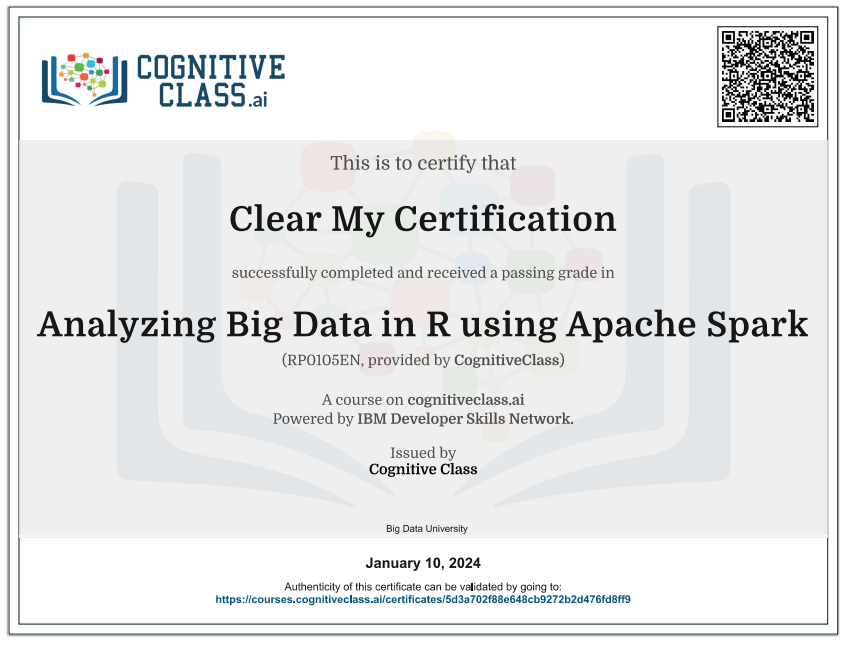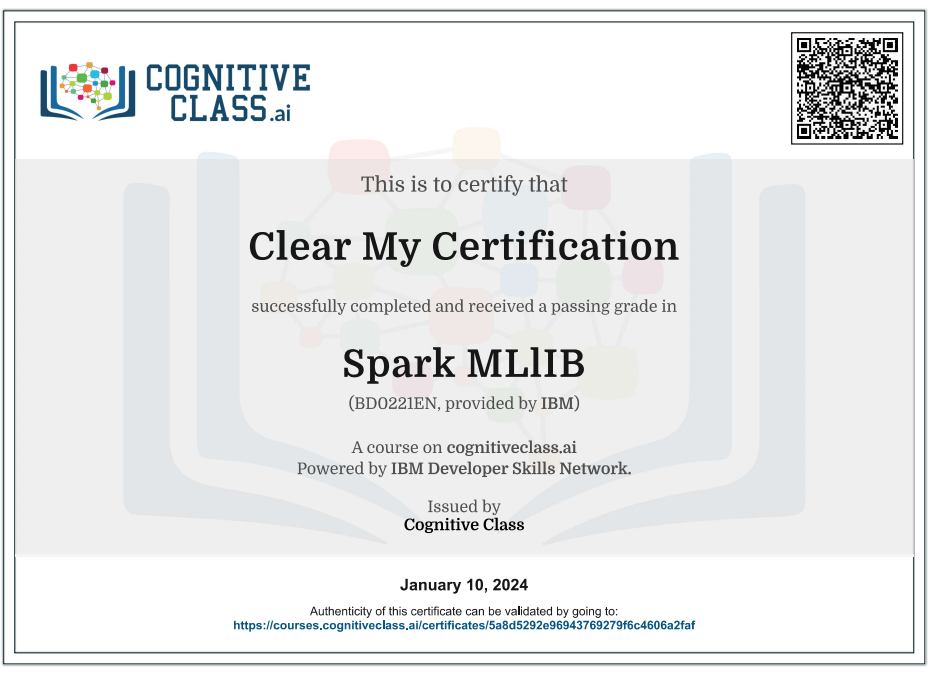Enroll Here: Docker Essentials: A Developer Introduction Cognitive Class Exam Quiz Answers
Docker Essentials: A Developer Introduction Cognitive Class Certification Answers

Lab 1: Run your First Container Quiz Answers – Cognitive Class
Question 1: Containers achieve isolation because of what feature in the Linux kernel?
- Namespaces
- Memory Swap management
- SystemD init system
- Permissions mechanisms
Question 2: What is the difference between a Docker container and a Docker image?
- Nothing: these are two words for the same thing.
- An image is the blueprint for spinning up containers. An image is a TAR of a file system, and a container is a file system plus a set of processes running in isolation.
- Images are used to create the host machine that runs the Docker Engine.
- Images are used only as a backup and restore mechanism for containers.
Question 3: Control groups (cgroups) limit and monitor resources.
- True
- False
Question 4: Which statement is not true about Docker?
- Docker makes it easier to package applications and add to CI/CD pipelines.
- Docker helps you package dependencies with containers.
- Docker invented containers and Linux namespaces.
- Docker simplifies container technology to make creating and running containers easier.
Question 5: What tool makes it possible to run Docker containers on operating systems other than Linux?
- LinuxByte
- OSContainers
- Docker Swarm
- LinuxKit
Lab 2: Add CI/CD value with Docker Images Quiz Answers – Cognitive Class
Question 1: Which file should you use to create reproducible builds for Docker images?
- docker.yml
- docker.config
- Dockerfile
- README.md
Question 2: To rebuild and re-push images quickly, you should optimize your Dockerfile for what?
- Reproducibility: ensures your Dockerfile will create the same image every time it is built
- Documentation: helps other engineers build and push images faster
- Time to market: enables business users to get their features out faster
- The layer cache: put lines that change more frequently near the end of the file
Question 3: You must use Docker Hub as the central registry to share the Docker images that you create.
- True
- False
Question 4: What’s the purpose of the FROM line in a dockerfile? Select all that apply.
- It executes commands needed to set up your image for an application.
- It’s required as the first line in a Dockerfile.
- It copies a file into a directory.
- It specifies the starting image to build other image layers on top of.
Question 5: What does this command do: $ docker system prune.
- Stops and removes containers
- Stops running containers
- Retrieves a list of running containers
- Removes containers that are already stopped
Lab 3: Orchestrate applications with Docker Swarm Quiz Answers – Cognitive Class
Question 1: What is the operational model used by Docker Swarm for managing a cluster?
- Declarative
- Imperative
- Closed-source
- Non-existent
Question 2: What effect does the routing mesh have on a Docker swarm cluster?
- Commands, such as “docker service create,” that are sent to any node on the cluster will be routed to a manager that can respond to those commands.
- Requests that are sent to a published port on any node of the swarm will automatically be routed to a node that is running a container for that service.
- Every service that is created on the cluster will schedule at least one container for every node in the cluster to ensure global availability.
- You can enable the routing mesh to use layer-7 load balancing in front of your running containers.
Question 3: he “docker swarm init command” generates a join token. What is the purpose of that token?
- It allows you to remotely control production applications.
- It initializes a swarm.
- It makes sure that no malicious nodes join the swarm.
- It outputs nodes in a swarm.
Question 4: When you run the following command, which of the following events does not occur?
$ docker service update –replicas=5 –detach=true nginx1
nginx1
- The state of the service is updated to 5 replicas, which is stored in the swarm’s internal storage.
- Docker Swarm recognizes that the number of replicas that is scheduled now does not match the declared state of 5.
- This command checks aggregated logs on the updated replicas.
- Docker Swarm schedules 5 more tasks (containers) in an attempt to meet the declared state for the service.
Question 5: The more manager nodes you have, the easier it is to achieve a consensus on the state of a cluster.
- True
- False
Docker Essentials: A Developer Introduction Final Exam Answers – Cognitive Class
Question 1: What is one advantage of isolation that is provided by containers?
- Container isolation provides a mechanism for immutable infrastructure.
- Containers running in isolation means that you don’t have to deal with conflicting dependencies that are installed on the host or other containers.
- Isolated containers make it easier to monitor applications running inside of containers.
- Each isolated container provides you with an SSH server that can be used for debugging or automation purposes.
Question 2: What factors should you consider when you choose your FROM image?
- Size
- Security
- Source
- All of these
Question 3: What is the best way to distribute a Dockerized application to different environments?
- Maven Nexus repository
- Docker registry
- Source control
- Any of these
Question 4: What is a good starting point for the number of manager nodes in a cluster?
- 3
- 1
- 4
- > 10
Question 5: Running containerized applications in production can come with a variety of problems. Which of the following items is not a problem of running a containerized application in production?
- Scheduling containers across a distributed cluster
- High availability
- Scaling
- “Works on my machine” syndrome
Question 6: What is one advantage of using containers across different environments?
- Deploying containers only once, and Docker will deploy across all environments automatically
- Avoiding environmental drift caused by maintaining multiple environments
- Redeploying containers
- Creating independent applications
Question 7: You need an SSH server to get a bash shell inside a container.
- True
- False
Question 8: What technologies are behind Docker’s image layering system?
- Linux namespaces and control groups
- Storage driver plugins
- Union file system and copy-on-write
- Docker build and push caching
Question 9: What is the result of running the command “docker run ubuntu:15.04” 1000 times on your workstation?
- Your workstation will run 1000 Ubuntu containers and will likely handle this just fine.
- Your workstation will crash from being out of space if it’s running with 100 GB of storage or less.
- Your workstation will crash from being out of memory if it’s running with less than 4 GB of RAM.
- The developer-friendly interface of the Docker CLI will prevent you from doing something so silly.
Question 10: Open-source container orchestration platforms, such as Docker Swarm and Kubernetes, provide what to their users?
- A way to orchestrate different flavors of the same application in a way that maximizes reuse
- A fully hosted solution that is production-ready for deploying enterprise grade applications
- An easy-to-use GUI for operators to click and deploy applications
- A platform to help solve problems of running distributed containerized applications in production, such as high availability, scaling, fault tolerance, and scheduling
Introduction to Docker Essentials: A Developer Introduction
“Docker Essentials: A Developer Introduction” would likely refer to a course or resource aimed at introducing developers to the essential concepts and practices of Docker, a platform for developing, shipping, and running applications in containers. Containers provide a lightweight and consistent environment, enabling applications to run consistently across different environments.
Here are some key topics that might be covered in a Docker Essentials course for developers:
- Introduction to Docker:
- Understanding what Docker is and its role in the software development lifecycle.
- Docker architecture and components.
- Installation and Setup:
- Installing Docker on various operating systems (Windows, macOS, Linux).
- Configuring Docker for development environments.
- Docker Images:
- Building Docker images using Dockerfiles.
- Working with base images and layers.
- Pushing and pulling images from Docker Hub.
- Containers:
- Creating and running containers.
- Configuring container networking.
- Managing container lifecycle.
- Docker Compose:
- Defining multi-container applications using Docker Compose.
- Orchestrating services in a development environment.
- Data Management:
- Managing data in Docker containers.
- Using volumes for persistent data.
- Docker Hub and Registries:
- Publishing and sharing Docker images on Docker Hub.
- Working with private registries.
- Docker Networking:
- Understanding Docker networking concepts.
- Connecting containers and services.
- Best Practices:
- Best practices for creating efficient and secure Docker images.
- Optimizing container performance.
- Integration with Development Workflow:
- Incorporating Docker into the development workflow.
- Using Docker with version control systems.
- Monitoring and Logging:
- Monitoring containerized applications.
- Logging and debugging Docker containers.
- Security Considerations:
- Securing Docker containers and images.
- Implementing best practices for container security.
This kind of course is valuable for developers who want to leverage Docker for consistent and reproducible development environments, streamline the deployment process, and gain an understanding of containerization concepts. It is common for such courses to include hands-on exercises and real-world examples to reinforce the learning experience.
 Clear My Certification All Certification Exam Answers
Clear My Certification All Certification Exam Answers



